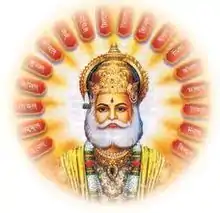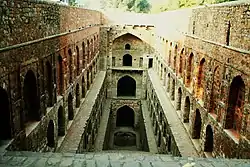Agrawal
Agrawal (anglicised as Agarwal, Agerwal, Agrawala, Agarwala, Agarwalla, Aggarwal, Agarawal, Agarawala) is a community found throughout northern, central and western India, mainly in the states of Rajasthan, Haryana, Punjab, Chandigarh, Himachal Pradesh, Uttarakhand, Delhi, Chhattisgarh, Gujarat and Uttar Pradesh.[4][5] Members of the Agarwal community were also found in what are now the Pakistani provinces of Punjab and Sindh, though at the time of the partition of India, most of them migrated across the newly created border to independent India.[6][7][8] The total Agrawal population in India is estimated to be around 10-15 million, which makes them around 1% of the Indian population.[9] Most Agarwals follow the Vaishnava denomination of Hinduism, though some have converted to Jainism.[10][11][1][2][3] Agrawals are divided into eighteen exogamous clans (gotras).[12] Many members of this community use their caste name Agarwal as their surname, while others use that of their gotras.[13]
 Maharaja Agrasen, the legendary king from whom Agrawals claim descent | |
| Regions with significant populations | |
|---|---|
| India, Pakistan | |
| Languages | |
| Rajasthani, Punjabi, Gujarati | |
| Religion | |
| Majority: Vaishnava Hinduism[1] Minority: Jainism, Islam, Christianity[1][2][3] |
Members of the Agrawal community are known for their business skills and have for many years been influential and prosperous in India. In 2016, the most common surname of the directors of the companies listed in the National Stock Exchange of India was Agarwal (and its variations). The second most common surname was Gupta.[14] Even in modern-day tech and ecommerce companies, they continue to dominate. It was reported in 2013, that for every 100 in funding for e-commerce companies in India, 40 went to firms founded by an Agrawal.[15] Of a total of 4 startups out of India that have crossed $10 Billion valuation (see List of unicorn startup companies), all except Paytm were founded by an Agrawal.
Legend

The Agrawals claim descent from kshatriya king Maharaja Agrasen of the mythological Solar Dynasty.[17] Literally, Agrawal means the "children of Agrasen" or the "people of Agroha", a city in ancient Kuru Panchala, near Hisar in Haryana said to be founded by Agrasen.[18]
History
Agrawals are at the forefront of the larger Bania community, which includes other mercantile communities like Maheshwari and Oswals.[4]
The Agrawal community traces it origins to Agreya Agroha, near Hisar, Haryana, which is part of the wider Punjab region. The view is supported by historical evidence.
- In Pradumna Charita of samvat 1411, the Agrawal poet Sadharu wrote "अगरवाल की मेरी जात, पुर आगरोए महि उतपात" ("My jāti is Agarwal, and I trace my roots to the city of Agroha).[19]
- In his Padma Purana[20] of VS 1711, Muni Sabhachandra writes "अग्रोहे निकट प्रभु ठाढे जोग, करैं वन्दना सब ही लोग|| अग्रवाल श्रावक प्रतिबोध, त्रेपन क्रिया बताई सोध||", (When Lohacharya was near Agroha, he taught the 53 actions to the Agrawal shravakas).
- In a Sanskrit inscription, the Agrawals are referred to as Agrotaka ("from Agroha"): "सं १३२९ चैत्र वुदी दशम्यां बुधवासरे अद्येह योगिनिपुरे समस्त राजावलि-समलन्कृत ग्यासदीन राज्ये अत्रस्थित अग्रोतक परम श्रावक जिनचरणकमल".[21]
During the Vikram era, some Agarwals converted from Hinduism to Jainism under the influence of Loha Charyaji.[1]
Migration to Delhi
The Agrawal merchant Nattal Sahu, and the Agrawal poet Vibudh Shridhar lived during the reign of Tomara King Anangapal of Yoginipur (now Mehrauli, near Delhi).[22] Vibudh Shridhar wrote Pasanahacariu in 1132 AD, which includes a historical account of Yoginipur (early Delhi near Mehrauli) then.
In 1354, Firuz Shah Tughluq had started the construction of a new city near Agroha, called Hisar-e-Feroza ("the fort of Firuz"). Most of the raw material for building the town was brought from Agroha.[23] The town later came to be called Hisar. Hisar became a major center of the Agrawal community. Some Agrawals are also said to have moved to the Kotla Firoz Shah fort in Delhi, built by Firuz Shah Tughlaq.
Migration to Rajput kingdoms
Many Marwari farmers migrated from Rajasthan. They form large fraction of the merchant population of Shekhawati region. Along with Maheshwari, Khandelwal and Oswals, they form the Marwari farmer community.
During the era of Islamic administrative rule in India, some Agarwal, as with the Saraogi, migrated to the Bikaner State.[24] The Malkana include Muslim Agarwals, who converted from Hinduism to Islam during this time and were given land tracts along the Yamuna by Afghan rulers.[2]
In the early 15th century, Agrawals (sweet maker) flourished as a Halwai trader community, under the Tomaras of Gwalior.[25] According to several Sanskrit inscription at the Gwalior Fort in Gwalior District, several traders (Sanghavi Kamala Simha, Khela Brahmachari, Sandhadhip Namadas etc.) belonging to Agrotavansha (Agrawal clan) supported the sculptures and carving of idols at the place.[26] Historian K.C. Jain comments:
Golden Age of the Jain Digambar Temple in Gwalior under the Tomara rulers inspired by the Kashtha Bhattarakas and their Jaina Agrawal disciples who dominated the Court of father and son viz. Dungar Singh (1425-59)and Kirti Singh (1459-80) with the Poet-Laureate Raighu as their mouthpiece and spokesman, a centenarian author of as many as thirty books, big and small of which two dozen are reported to be extant today. Verify the advent of the Hisar-Firuza-based Jain Agrawals who functioned as the ministers and treasurers of the ruling family had turned the Rajput State of Gwalior into a Digambara Jain Centre par excellence representing the culture of the Agrawal multi-millionner shravakas as sponsored by them.[25]
In 15th century, many NonAgrawals farmer migrated to Amber kingdom (now Jaipur). In VS 1535, Agrawal Nenasi conducted a pratishtha ceremony at Sanganer.[27] A copy of Amarsen Chariu copied in VS 1577 at Sonipat was found at Amber, suggesting that Agrawals took sacred texts with them during this migration.[28]
Migration to Eastern India
Later, during the Mughal rule, and during the British East India Company administration, some Agrawals migrated to Bihar and Calcutta, who became the major component of the Marwaris.[29]
Notable Agrawals
Agrawals are a successful community with representation in almost all spheres. While they are generally present in business and politics, the community has produced a lot of successful scientists, inventors, authors, etc.
Gotras
Historically, there has been no unanimity regarding number and names of gotras, and there are regional differences between the list of gotras. The Akhil Bhartiya Agrawal Sammelan, a major organization of Agrawals, has created with a standardized list of gotras, which was adopted as an official list by a vote at the organization's 1983 convention.[30] Because the classification of any particular gotra as "half" is considered insulting, the Sammelan provides a list of following 18 gotras:[31]
The existence of all the gotras mentioned in the list is controversial, and the list does not include several existing clans such as Kotrivala, Pasari, Mudgal, Tibreval, and Singhla.[32]
See also
References
Notes
Citations
- Singh, K. S. (2008). People of India: Bihar. Anthropological Survey of India. p. 46. ISBN 978-81-85579-09-2.
The bulk of the Agrawals belong to Vaishnava sect of Hinduism. ... Agrawals, it is believed, were converted to Jainism by Sri Loha Charyaji between 27 and 77 years of the Vikram era.
- Sikand, Yoginder; Katju, Manjari (20 August 1994). "Mass Conversions to Hinduism among Indian Muslims". Economic and Political Weekly. 29 (34): 2214–2219.
- John, Jose Kalapura (2000). Proceedings of the Indian History Congress, Vol. 61. Indian History Congress. p. 1011-1022.
- Hanks, Patrick (8 May 2003). Dictionary of American Family Names. Oxford University Press. p. xcvi. ISBN 978-0-19-977169-1.
The Banias of northern India are really a cluster of several communities, of which the Agarwal Banias, Oswal Banias, and Porwal Banias are mentioned separately in connection with certain surnames.
- https://www.livemint.com/Leisure/TYwWWYXGX3L72a1psxhe3N/A-history-of-the-Agarwals.html
- Gupta, Babu Lal (1987). Trade and Commerce in Rajasthan During the 18th Century. Jaipur Publishing House. p. 88.
- Das, Sibir Ranjan (2012). Resilience and Identity in Urban India: Anthropology of Barmer and Tehri. Anthropological Survey of India. p. 107. ISBN 978-81-922974-9-1.
- Gulzar Ahmed Chaudhry (4 June 2014). "Nagar Mahal – from Agarwals to Sukheras". Dawn.
- Gupta, Vipin; Khadgawat, Rajesh; Ng, Hon Keung Tony; Kumar, Satish; Rao, Vadlamudi Raghavendra; Sachdeva, Mohinder Pal (December 2010). "Population Structure of Aggarwals of North India as Revealed by Molecular Markers". Genetic Testing and Molecular Biomarkers. 14 (6): 781–785. doi:10.1089/gtmb.2010.0095. PMC 3490109. PMID 20979565.
- Singh, K. S. (1998). Rajasthan. Popular Prakashan. p. 19. ISBN 978-81-7154-766-1.
- Goh, Robbie B. H. (8 February 2018). Protestant Christianity in the Indian Diaspora: Abjected Identities, Evangelical Relations, and Pentecostal Visions. SUNY Press. ISBN 978-1-4384-6944-7.
- Frazer, Sir James George (1935). Totemism and Exogamy: A Treatise on Certain Early Forms of Superstition and Society. Macmillan and Company. p. 283.
Other instances of totemic clans in the Punjab are perhaps to be found in the Agarwal group of Banias, who are divided into fourteen exogamous clans (gots).
- Singh, K. S. (1992). People of India: Odisha. Anthropological Survey of India. p. 1136. ISBN 978-81-7046-294-1.
The different Bania groups adopt their surname in accordance with their community name viz., Agarwal, Maheswari, etc., or according to their gotra name e.g., Singhal, Soni, Nahata, etc.
- https://qz.com/india/669503/whats-an-indian-boardroom-without-an-agarwal-or-a-gupta/
- Julka, Harsimran; Radhika P. Nair (12 February 2013). "Why young Aggarwals dominate India's e-commerce start-ups". The Economic Times. Delhi.
- Down to Earth: Science and Environment Fortnightly, Volume 16, Issues 16-24. Society for Environmental Communications. 2008. p. 71.
Resembling Tughlak period architectures, it was probably constructed by the Agrawal community (tracing back to Maharaja Agrasen).
- Mittal, J. P. (2006). History of Ancient India: From 4250 BC to 637 AD. Atlantic Publishers. p. 675. ISBN 978-81-269-0616-1.
- Sarda, Har Bilas (1935). Speeches and Writings. Ajmer: Vedic Yantralaya. p. 120.
- Dr. Kasturachand Kasliwal, Khandelwal Jain Samaj ka Vrihad Itihas, 1969, p. 49
- Muni Sabhachandra aur Unaka Padmapurana, Kasturchanda Kasliwal, 1984
- Parmananda Jain Shastri. Agrawalon ka Jain sanskriti mein yogadan. Anekanta Oct. 1966, p. 277-281
- An Early Attestation of the Toponym Ḍhillī, by Richard J. Cohen, Journal of the American Oriental Society, 1989, p. 513-519
- The story of Hisar
- Rajasthan District Gazetteers: Churu. Government Central Press. 1962. p. 50.
- Kashtha Sangha Bhattarakas of Gwalior and Agrawal Shravakas, Dr. K. C. Jain
- "गोपाचल के जिन मन्दिर एवं प्रतिमाएँ" (in Hindi). Webdunia.com. Archived from the original on 24 December 2004. Retrieved 2 June 2007.
- Jain Inscriptions of Rajasthan, R.V. Somani, 1982
- Amarasena Chariu, Dr. Kasturchand Jain Suman, 1990
- Anne Hardgrove, Community and Public Culture: The Marwaris in Calcutta, New Delhi, Oxford University Press (2004) ISBN 0-19-566803-0
- Lawrence A. Babb 2004, pp. 193-194.
- Lawrence A. Babb 2004, p. 192.
- Lawrence A. Babb 2004, p. 193.
Further reading
- Hardgrove, Anne (2004). Community and Public Culture: The Marwaris in Calcutta, c. 1897–1997. Columbia University Press. ISBN 978-0-23112-216-0.